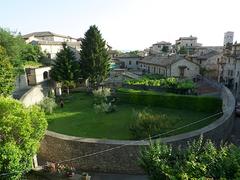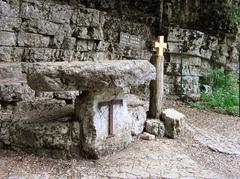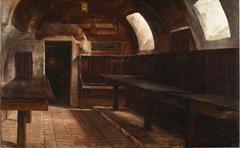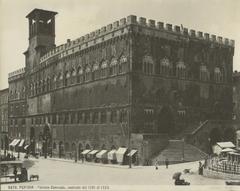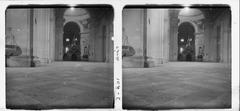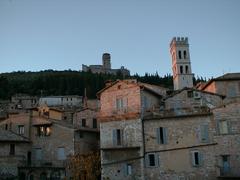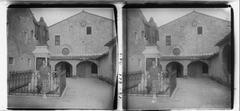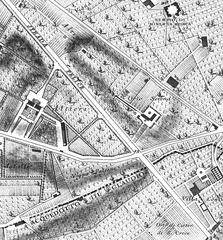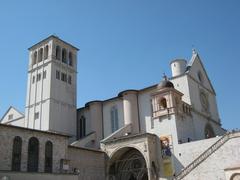Castello dei Figli di Cambio: Visiting Hours, Tickets, and Historical Significance in Assisi
Date: 14/06/2025
Introduction
Nestled in the picturesque Umbrian countryside near Assisi, the Castello dei Figli di Cambio stands as a distinguished example of medieval military architecture and regional heritage. Constructed in 1385 by the Lombard feudal lord Cambio (or Cagno), the castle was designed as a fortified village, safeguarding both the local community and vital trade routes. Today, it serves not only as a historical monument but also as a vibrant cultural venue, most notably hosting the annual Cambio Festival. This guide provides a detailed overview of the castle’s history, architectural highlights, visiting information, and practical travel tips, allowing visitors to fully experience one of Assisi’s most captivating sites (Ticket Italia; iluoghidelsilenzio.it).
Table of Contents
- Introduction
- Historical Origins and Feudal Role
- Architectural Features and Restoration
- Cultural and Socio-Economic Significance
- The Castle in the Context of Assisi and Umbria
- Modern Revival: Events and Festivals
- Visitor Information
- Frequently Asked Questions (FAQ)
- Visuals and Media
- Key Sources and Official Links
- Conclusion and Call to Action
Historical Origins and Feudal Role
The Castello dei Figli di Cambio arose during the late 14th century, a time marked by regional strife among feudal lords. Built in 1385 under Cambio (or Cagno), the castle’s quadrangular design, four corner towers, moat, and drawbridge exemplify the defensive priorities of the period (Ticket Italia). The “Sons of Cambio” (Figli di Cambio) reinforced its defenses, adding to its status as the last stronghold before Assisi during conflicts with Perugia.
Beyond its military function, the castle became an administrative and socio-economic hub for the region. The Cambio family, prominent landowners, managed agricultural production, trade, and local governance from within its fortified walls. Its strategic location near the Chiascio River and key trade routes contributed to the prosperity and resilience of the surrounding community (iluoghidelsilenzio.it; mondimedievali.net).
Architectural Features and Restoration
The castle’s defensive characteristics are evident in its robust stone walls, four square corner towers, and remnants of a moat and drawbridge. Constructed in a marshy area for additional defense, the castle’s features reflect the practical needs and military ingenuity of late medieval Umbria. Heraldic motifs and decorative stonework near the entrance and chapel testify to the family’s status and piety (iluoghidelsilenzio.it).
Successive restorations, especially in the late 20th century, have preserved the integrity of these features while adapting the castle for modern use. Although now surrounded by residential buildings, the castle’s core defensive architecture remains intact and evocative (mondimedievali.net).
Cultural and Socio-Economic Significance
Historically, the castle was more than a military outpost; it anchored the local economy and social structure. The Cambio family oversaw a large workforce of farmers and artisans, whose labor not only sustained agriculture but also supported craft traditions such as basket weaving—a legacy still present in the area. The castle’s name may derive from “cambiare,” referencing its role as a center for trade and commerce (iluoghidelsilenzio.it).
Loyalty to Assisi is commemorated in the red and blue colors of Palazzo, still visible on local flags and emblems. The castle’s adaptive reuse—in particular, its transformation into a cultural venue—continues to foster local economic growth and community pride (Porta Perugia Events).
The Castle in the Context of Assisi and Umbria
As part of a network of medieval fortifications, the Castello dei Figli di Cambio’s proximity to Assisi linked it to broader religious, political, and economic currents in the region. Today, its setting in the Umbrian landscape, surrounded by olive groves and vineyards, offers visitors a gateway to the rich heritage and natural beauty of central Italy (Earth Trekkers).
Modern Revival: Events and Festivals
The castle has embraced a dynamic cultural role, most notably as the site of the annual Cambio Festival. Held in July or August, the festival transforms the castle’s courtyards into stages for classical, jazz, and contemporary performances, as well as art exhibitions and food events. These cultural initiatives have revitalized the castle, attracting visitors from across Italy and beyond (Umbria24; sanfrancescopatronoditalia.it).
Proceeds from ticket sales and increased tourism during festival periods support local businesses and ongoing preservation efforts, ensuring the castle’s legacy for future generations (Porta Perugia Events).
Visitor Information
Location and Access
The Castello dei Figli di Cambio is located in the village of Palazzo, approximately 6 km northwest of Assisi, on the left bank of the Chiascio River. GPS: 43° 5’ 46.68” N, 12° 33’ 54.72” E. Access is via SR147 towards Pianello, with parking available nearby. The site is reached on foot from the village center (mondimedievali.net).
Visiting Hours and Tickets
- General Access: The castle is primarily residential, so the interior is not open for daily visits. The exterior and village can be explored at any time.
- During Events: Special openings occur during festivals, especially the Cambio Festival. Ticket prices for events range from €5 to €10, with discounts for children, students, and groups. Some festival events are free (ticketitalia.com; Porta Perugia Events).
- Where to Buy: Tickets for events can be purchased online or at the entrance during festival periods.
Guided Tours and Accessibility
- Guided Tours: Not regularly available due to private ownership, but special events may include guided or audio tours.
- Accessibility: The exterior and main paths are relatively flat, but the medieval layout and some uneven surfaces may challenge visitors with mobility impairments. Contact event organizers ahead of time for specific accessibility accommodations.
Nearby Attractions and Travel Tips
- Historic Assisi: The Basilica di San Francesco, Rocca Maggiore, and other fortresses are a short drive away.
- Local Crafts: The village maintains basket weaving traditions—an excellent opportunity to purchase authentic Umbrian handicrafts.
- Best Time to Visit: The area is most lively during the Cambio Festival; spring and autumn offer pleasant weather and fewer crowds.
- Amenities: Basic services are available in Palazzo, with a broader selection of restaurants and accommodations in Assisi (italyheaven.co.uk).
Frequently Asked Questions (FAQ)
What are the visiting hours for Castello dei Figli di Cambio?
There are no regular visiting hours for the interior; the exterior and village are freely accessible. The castle opens for special events, with hours published in advance.
Is there an entrance fee?
No fee for exterior visits. Event tickets are required during festivals or concerts.
Are guided tours available?
Guided tours are occasionally offered during special events.
How do I get there from Assisi?
Travel by car via SR147 towards Pianello, or use local buses connecting Assisi to Palazzo.
Is the castle wheelchair accessible?
The exterior is generally accessible, but the historic structure limits full accessibility.
Visuals and Media
- Include high-quality images of the castle’s exterior, towers, and event spaces. Use alt text such as “Castello dei Figli di Cambio medieval towers in Palazzo, Assisi.”
- Interactive maps and virtual tours are available on select tourism and heritage websites.
Key Sources and Official Links
- Ticket Italia
- Assisi Official Tourism
- Porta Perugia Events
- Iluoghi del Silenzio
- Umbria24
- Earth Trekkers
- mondimedievali.net
- sanfrancescopatronoditalia.it
- italyheaven.co.uk
Conclusion and Call to Action
The Castello dei Figli di Cambio stands as a vivid emblem of Umbrian medieval heritage, skillfully blending its defensive origins, architectural character, and vibrant community life. Its robust walls and towers are not only testaments to feudal ingenuity but also serve as backdrops for contemporary cultural events that celebrate the region’s spirit. Planning your visit around the Cambio Festival or other special openings offers the richest experience, combining history, art, and local tradition.
For current event schedules, ticketing, and travel tips, consult official sources and tourism platforms. Download the Audiala app for comprehensive guides and exclusive updates on Assisi’s historical sites, and follow us on social media for the latest news from Umbria’s living history.
